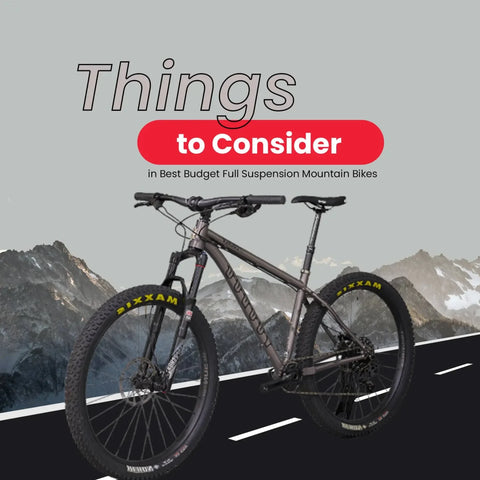
Finding the best budget full suspension mountain bikes is now within reach for every avid bike rider. However, riders often change their preferences when they find these bikes to be too expensive. As a result, many brands have begun investing in the production of low-budget suspension bikes.
Let’s dive into the nitty-gritty of these mountain bikes and explore how to pinpoint the right one for you.
What are the Best Budget Full Suspension Mountain Bikes?
Full-suspension mountain bikes have both front and rear shock absorbers. It allows going through rough trails to ride smoother. The front suspension, often called a fork, absorbs hits from rocks and roots.
Meanwhile, the rear suspension is connected by a pivot system. It cushions bigger bumps and improves traction. Finding a good quality full-suspension bike is critical if you’re on a budget but love mountain biking. These bikes ensure a comfy ride, better control, and less fatigue on bumpy trails. It’s like having a built-in trail buddy that’s got your back!
3 Benefits of Best Budget Full Suspension Mountain Bikes

Similar to men, women mountain bike trends are increasing day by day. Yet many off-road enthusiasts plan their trips together in a group. Here are some of these bike’s advantages:
Enhanced Comfort
Firstly, these bikes excel at smoothing out the jolts from rough trails, thanks to shock absorbers positioned both on the front and back. As a result, bid farewell to those jarring rides; your body will undoubtedly thank you after a long day on the trail.
Superior Control
Then, moving on to another advantage, full-suspension bikes excel at maintaining better ground contact. Consequently, you’ll experience enhanced control while navigating tricky sections, thereby reducing the chances of slipping or skidding.
Peak Performance
Thirdly, these bikes enable you to ride faster with confidence. The rear suspension, in addition to cushioning impacts, ensures better wheel traction. Therefore, whether you’re climbing steep hills or descending rocky paths, you can always count on experiencing a stable ride.
4 Types of Full Suspension Mountain Bikes

There are many types of men mountain bike. Let’s break down the main types:
Cross-Country (XC)
In contrast, XC bikes are specifically designed for speed and efficiency. Ideal for riders prioritizing climbing and long-distance riding, these bikes typically feature shorter travel, around 100-120mm. This design not only makes them lighter but also more agile.
Trail Mountain Bikes
Situated under the category of jack-of-all-trades in the mountain biking world, trail bikes offer versatility. With travel typically ranging between 120-150mm, these bikes strike a balance between climbing efficiency and downhill capability. This versatility renders them suitable for navigating a wide range of terrains.
All-Mountain (Enduro)
They are built for those who crave adventure and challenging terrains. All-mountain bikes have more travel, typically between 140-170mm, offering better shock absorption for technical descents. Also capable climbers, but their strength is tackling rough and steep terrains.
Downhill (DH)
It is the beasts of the mountain biking world. With travel often exceeding 200mm, downhill bikes are designed to take on the steepest, rockiest, and most challenging descents at high speeds. They’re typically heavier and not meant for climbing.
How Full Suspension Works?
The magic of full suspension lies in its ability to absorb shocks. Yet it keeps the wheel in contact with the ground. Want to explore more of its mechanics.
Front Suspension (Fork)
First of all, front of the bike houses the fork. Inside, there are two central systems: coil spring and air spring. As the fork encounters an obstacle, these springs compress, absorbing the shock. It’s damping mechanisms, often filled with oil, control the spring’s rebound. It ensures that it doesn’t bounce back too quickly.
Rear Suspension
Secondly, the rear suspension consists of a shock absorber. Yet, it has and a series of linkages and pivots. Like the fork, the shock absorber can be coil or air-sprung. These linkages and pivots allow the rear wheel to move up and down as the shock compresses and rebounds.
Adjustability
Thirdly, modern full suspension bikes often come with adjustment knobs. These allow riders to fine-tune suspension stiffness. Also, adjust based on their weight, riding style, and the terrain.
10 Things to Count for Best Budget Full Suspension Mountain Bikes
When you decide to buy a budget-friendly full suspension mountain bike. Remember these factors in mind before your final purchase:
- Frame Materials: The bike frame is the backbone of your ride.
- Aluminum: Most budget bikes use aluminum frames. It’s lightweight, durable, and balances performance and cost well.
- Steel: Heavier than aluminum but provides a smooth ride due to its natural vibration-damping properties. It’s generally less expensive but may add weight to the bike.
- Carbon Fiber: Rare in budget options, but if found, it offers a light and stiff frame with excellent vibration damping. However, be cautious of cheap carbon frames; their quality can be inconsistent.
- Wheel Size: Your wheels play a pivotal role in determining how the bike handles.
- 27.5-inch: Offers quicker acceleration and agile handling. Great for twisty trails and tight turns.
- 29-inch: Rolls over obstacles more efficiently and offers better traction. It is ideal for tall riders or those looking for a bit more stability on rough trails.
- Short Travel (100-130mm): Best for cross-country and light trail riding. It’s more efficient for climbing and provides a responsive ride.
- Medium Travel (130-160mm): Suited for general trail riding, all-mountain, and some downhill sections. It offers a good balance between uphill efficiency and downhill capability.
- Long Travel (160mm+): Built for downhill and enduro riding. It provides maximum shock absorption but might feel heavy on climbs.
To learn more about different parts of a bike, visit our comprehensive guide.



Final Words
To recap, the market for budget full-suspension mountain bikes is thriving, offering riders a diverse range of options to choose from. With advancements in technology and manufacturing processes, these bikes are becoming increasingly affordable without compromising on performance. By following the guidelines outlined in this article, you can find the perfect budget full-suspension mountain bike to elevate your riding experience and embark on unforgettable adventures. Lets ride to Mars together!
FAQs – Best Budget Full Suspension Mountain Bikes
What should I consider a full-suspension bike over a hardtail?
A full suspension bike offers shock absorption on both the front and rear offering a smoother ride on rough terrains and providing better traction and control (especially on descents).
Is aluminum or steel better for a bike frame?
Aluminum is lighter and is the most common material for budget bikes. Steel, while heavier, offers natural vibration damping for a smoother ride. The choice depends on your budget and preference for weight versus conveyance comfort.
Can I use a 29-inch wheel bike for technical trails?
Absolutely! While 29-inch wheels offer stability and roll over obstacles quickly, they can handle technical trails. The key is to get used to the bike’s handling characteristics.
How often should I service my full suspension system?
For regular riders, it’s crucial to check the suspension every 50 hours of ride time for any signs of wear or damage. Furthermore, a comprehensive full service by a professional should be conducted annually or, alternatively, every 200 hours of riding. This proactive maintenance approach ensures the longevity and optimal performance of your mountain bike.
To learn more visit our maintenance guide.
What are some maintenance tips for bikes?
To maintain optimal performance, it’s essential to keep the pivots and linkages clean and well-lubricated. Additionally, regularly check for any play in the suspension components. Moreover, it’s crucial to always inspect the shock absorbers for any signs of leaks or damage. This routine care will contribute to the longevity and reliability of your mountain bike’s suspension system.
To learn more visit our maintenance guide.
Are there any must-have accessories?
Consider a quality mudguard to protect your suspension from dirt. A dropper seat post can be beneficial for adjusting saddle height on the fly, and shock pumps allow for precise suspension tuning.
To learn more check out our guide on picking the right accessories.
What upgrades can boost my bike’s performance?
Upgrading to a higher-quality suspension fork or rear shock can improve ride quality. Tubeless tire setups can offer better traction and puncture resistance. As well as, consider better brake systems which provides quick stopping power.






